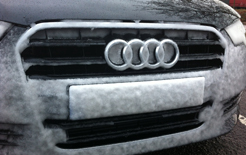
Editor’s Blog on driving advice for the white stuff
THE weather forecast is varied at the moment: will we, won’t we have a white Christmas?
Of course we all like the fairytale scene of waking up on Christmas day and finding a white blanket has been deposited on everything and that strange silent stillness in the air.
It looks unlikely at the moment as the forecast is for milder temperatures. But that doesn’t mean that various parts of the country aren’t hit by hazardous driving conditions.
I was driving up on Sunday to see my parents in Suffolk and we were hit by a snow blizzard on the M11. The forecast had suggested it would be sunny if cold – big and thickening snow was definitely not on the cards.
Which is why business drivers – and anybody on the roads over the Christmas period – should always make sure they are prepared for deteriorating conditions. A business trip covering 400 miles can take in a lot of variable conditions – including driving in the snow.
I watched the outside temperature read out on my Audi A6’s Driver Information System gradually drop to just below freezing as the snowflakes became larger and started to settle on the motorway.
So what should you do if you do have to end up driving in the snow? I asked IAM chief examiner Peter Rodger for some advice for business car drivers. He told me: “Avoid travelling unless completely necessary, and don’t ignore police warnings or advice to not travel on specific routes. Can you work remotely, or change your schedule?”
All of which is top advice. But what if you don’t have the option of staying at home? Or what happens if conditions change suddenly during the day?
Peter had the following advice on driving safely in snow:
Make sure your windows are clear and that you have all-round visibility before you set off. Also take the time to clear snow off the roof of your car
When driving in snow, get your speed right – not too fast that you risk losing control, but not so slow that you risk losing momentum when you need it
Start gently from stationary, avoiding high revs. Stay in a higher gear for better control, and if it is slippery, in a manual car move off in a higher gear, rather than just using first
If you get yourself into a skid the main thing to remember is to take your foot off the pedals and steer
Only use the brake if you cannot steer out of trouble. Double or even triple your normal stopping distance from the vehicle in front so you are not relying on your brakes to be able to stop. It simply may not happen!
It’s better to think ahead as you drive to keep moving, even if it is at walking pace
Plan your journey around busier roads as they are more likely to have been gritted. Avoid using short cuts on minor roads – they are less likely to be cleared or treated with salt, especially country lanes and housing areas
Bends are a particular problem in slippery conditions – slow down before you get to the bend, so that by the time you turn the steering wheel you have already lost enough speed
On a downhill slope get your speed low before you start the descent, and do not let it build up – it is much easier to keep it low than to try and slow down once things get slippery
And if the worst does happen: Keep track of where you are. If you do have to call for assistance, you need to be able to tell the breakdown or emergency services your location, so they can find you
If you must leave your vehicle to telephone for assistance, find a safe place to stand away from the traffic flow. If you have just lost control the next driver could well do the same in the same place
On motorways and dual carriageways it is always better to leave your vehicle and stand a short distance behind and to the safe side of it. Don’t stand in front of it if at all possible.
Previous blog on the editor’s Audi A6
Dangerous driving habits close to home







